Water purification from the well: what to do if the water in the well is cloudy or turns yellow
Water from a well is not always clean, healthy, and tasty. Foreign impurities, pathogenic bacteria and even toxic substances can be found in it. Only a detailed analysis of the water will help to find out whether the “produced” liquid is suitable for drinking and household needs.
If the results of the study turn out to be unsatisfactory, this is an occasion to closely address the issue of its cleaning and filtration.
The article details information on how to organize a check of the qualitative composition of water, which laboratories should be trusted. We described how water is cleaned from the well, what stages of water treatment are mandatory in a given situation.
The content of the article:
Danger of using contaminated water
A person is 70% water, so its impact on our health is colossal. The consumption of low-quality liquid leads to a decrease in immunity, greatly increases the risk of various viral, bacterial and allergic diseases.
In addition, the use of contaminated water in everyday life is fraught with damage to expensive equipment (dishwashers and washing machines, boilers, kettles), clogged pipes, the occurrence of an unpleasant hard-to-remove plaque on the plumbing.
Therefore, to maintain your own health and contents of the wallet, it is very important to understand what water flows from the taps in the house.

Water research: what is important to know?
Laboratory methods for studying water from a well are carried out to determine its potability. In some cases, experts strongly recommend their implementation.
Reasons to analyze
Among the good reasons for checking the quality of water are:
- Sale of suburban real estate. The expert opinion on the high quality of water on the site greatly increases its attractiveness in the eyes of buyers in the sale.
- Buying land. Having bought a land plot, it is necessary to make a water analysis to be sure of its safety.
- The occurrence of health problems. An increase in the number of colds and gastrointestinal upsets can be directly related to the presence of harmful impurities in drinking water.
- The desire to purchase a water purification system. To select the optimal filtration unit, it is necessary to find out the degree of contamination of the liquid.
It is mandatory to conduct a water analysis in the event of a deterioration in its organoleptic characteristics - color, taste, smell, transparency. If the color changes upon contact with air: it turns yellow or even turns brown, spots remain on clothing and plumbing, and iron concentration is likely to be increased in it.

The smell of rotten eggs emanating from the liquid indicates an excess of hydrogen sulfide. In no case should you drink such water, since it can be toxic. Increased mineralization gives the liquid a salty taste.
The constant use of water with a large number of sodium ions can aggravate the course of hypertension, and, in general, is not good for health.
The appearance of muddy water in the well should certainly be alerted - this may indicate both mechanical contamination of the liquid and chemical-biological "problems" of the source.
Assessment of the quality of drinking well water should be carried out regularly - at least once every 1-2 years. The composition of the water changes periodically - both due to natural climatic causes (high water, drought), and through the fault of humans.
Chemical waste and toxic substances seeping into the soil can penetrate into aquifers, and these changes, unfortunately, are not noticeable to the naked eye.
Therefore, "keeping abreast", periodically checking the composition of the consumed water, is always necessary.
As for assessing the quality of water in a new well, it is definitely not worth rushing here. A thorough production flushing and wait 3-4 weeks, when the pollution caused by installation work is leveled by itself.
Features of the choice of laboratory
There are many laboratories carrying out water research. But preference should be given only to trusted companies that have licensed evidence of the right to conduct analyzes.
Specialists recommend contacting only large companies with many years of experience in this service sector. Do not be tempted by the low price; focus should only on the quality of work and real customer reviews.

When contacting small companies, it is worth considering the fact that often they are intermediaries and do not have their own laboratories, i.e. “Redirect” samples for analysis to other offices.
In this case, you can’t count on quick results. Therefore, when choosing a laboratory, always be interested in whether the company has its own resources to perform the necessary analyzes, as well as a license with the right to conduct research.
Stages and cost of testing
The first stage of the study is competent water sampling. This process can be either entrusted to laboratory staff or performed independently.
In the second case, it is very important to pay attention to such points:
- It is advisable to take water tanks in the laboratory. In the one where the analysis will be performed. These containers underwent special processing; preservatives were added to them, which ensure the stability of the chemical composition of the liquid. The use of dishes prepared by the laboratory is the key to obtaining the most reliable test results.
- Laboratory containers must not be rinsed. You should also not drain water from them and recycle.
- Use clean containers. If it is not possible to take the bottles in the laboratory, then you can use clean glass or plastic containers from under drinking water.
Please note that containers for sweet drinks, untreated with copious amounts of running water, are absolutely not suitable! Sampling for the content of petroleum products, fats and other organic indicators should be made in a container of dark glass.
Independent sampling of water significantly reduces the total cost of the study, but carries the risk of distortion of objective data with a neglect of the process.
Be sure to observe the following sampling rules:
- All manipulations should be done with clean, thoroughly washed hands with soap.
- Own dishes for delivering water to the laboratory should be absolutely clean and free from odors (optimal container capacity is 1.5-2 l). Before filling it should be rinsed three times with water to be analyzed.
- The drain time from an autonomous water supply before sampling should be at least 5 minutes.
- Filling the tank must be carried out with a thin stream along the wall of the tank. It is forbidden to change the water pressure by opening or closing the tap.
- The container should be filled with water to the top (under the lid itself): air in the container may affect the test results.
- Water bottles must be signed - indicate the time, place and date of sampling.
- It is very important that the samples reach the laboratory without delay - no later than 2 hours after collection. If prompt delivery is not possible, the sample should be refrigerated. This will increase the "shelf life" of the selected water up to 12 hours.
To assess the quality of well water, various types of analyzes are carried out - chemical, organoleptic, microbiological, advanced. The cost of the study depends on the number of defined indicators and a set of additional services. On average, a standard analysis will cost 1,500-2,000 rubles, a full analysis will cost 4,000-5,000 rubles.

All standards that water of a private water supply system must comply with are established in Section 4 of SanPiN 2.1.4.1175-02.
Among the required indicators for assessing the quality of a liquid:
- smell;
- color
- turbidity;
- taste;
- hydrogen indicator (pH);
- nitrates;
- general rigidity;
- permanganate oxidizability;
- general mineralization;
- chlorides;
- sulfates.
The list of indicators recommended by many laboratories for analysis also includes iron, nitrites, fluorides, manganese.
If you donate water for research on a regular basis, you can limit your analysis to a basic list of indicators that includes only those items for which excesses are most often recorded: pH, hardness, odor, iron, manganese, permanganate oxidation, general mineralization.
Such an analysis will make it possible to draw general conclusions about the quality of well water, but it will not make it possible to assess generally its compliance with established standards.

Microbiological examination of the fluid is performed according to the following indicators:
- total microbial number;
- common colimorphic bacteria;
- coliphages;
- thermotolerant colimorphic bacteria.
You can get test results in most large laboratories after 2-5 days. Small firms cope a little slower - it takes 7-14 days to prepare the study protocol.
Well water treatment methods
Test results that fit into all the rules are excellent. In this case, you don’t have to worry about a special additional filtration of the liquid.
However, if foreign impurities or hazardous concentrations of elements were detected in the water, it is imperative to take care of its high-quality cleaning.
Typically, water is purified in several stages. Their quantity is determined by the degree and types of pollution.
A complete scheme for cleaning water from a well consists of the following elements:
- coarse cleaning module, consisting of one or more filters;
- iron removal filter;
- softener;
- carbon filter;
- disinfectant;
- installation for fine cleaning (preparation of drinking water).
The more levels has water treatment system, the better water quality is obtained at the outlet. Nevertheless, it is not worthwhile to “overload” your wallet with the purchase of an entire arsenal of devices for cleaning - you need to solve real problems, confirmed by analysis results.
Method # 1 - rough cleaning
This stage of water treatment is necessary to remove mechanical suspension from the liquid: large particles of clay and sand, rust, silt, scale. Correctly selected coarse filters provide the possibility of uninterrupted operation of thinner filters - they are installed at the beginning of the water treatment system.
The liquid is cleaned from large impurities by passing through a grid system.
Periodically mechanical filters heavily contaminated and require flushing. To get rid of the need to dismantle the elements and stop the water supply at the same time, it is recommended to install self-washing filters - they are cleaned with a jet stream.
A reliable choice will be the device company Honeywell (USA) or Drufi (Germany).
You can build a downhole filter with your own hands using perforated pipes or a mesh “sleeve”. Detailed information on the manufacture of the filter element is described in this article.
Method # 2 - use softeners
A high concentration of magnesium and calcium salts makes the water hard.Such water adversely affects the operation of plumbing equipment, as well as water-using electrical appliances.
Deposits on heating elements (scale), limescale on pipes, valves, shower nozzles, etc. - only a small part of the possible consequences.
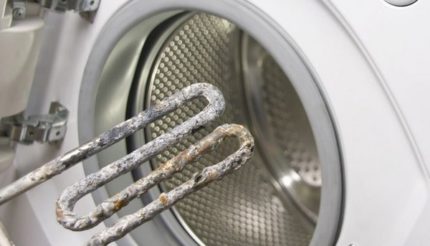
Well water softening is a problem that can be solved in several ways. It is cheaper to do this using equipment using the proportional dosing method of a special reagent that neutralizes hardness salts.
Such devices, for example, Quantomat from Bwtare a flask with a dispenser filled with reagent.
Portions of the reagent, measured by the dispenser, depend on the volume of water passing through the neutralizer. Unfortunately, this method does not allow us to talk about the full softening of water, since magnesium and calcium salts are not removed from the liquid, but only deactivated.
Only complex installations can provide full-fledged softening, the principle of functioning of which is based on ion exchange — the replacement of calcium ions by sodium ions. To do this, the liquid comes into contact with the ion exchange resin.
The source of sodium ions is a solution of sodium chloride. Such equipment is quite expensive, but its use in a country house for drinking well water preparation is justified.

Method # 3 - using iron removers
Iron is often not associated with a toxic substance in an ordinary person. Therefore, many simply ignore the need for iron removal from well water. But in vain. Excess of this element in drinking water can provoke a number of internal diseases and a general weakening of the body.
Iron removal is carried out by special filters, the principle of which is based on the conversion of iron from a soluble form into an insoluble precipitate by oxidation.
Oxidation of iron dissolved in liquid can be carried out in two ways:
- reagentless - artificial or natural aeration;
- reagent - using chemicals.
The principle of operation of pressureless reagentless plants is as follows: forced oxygen saturation of water occurs in a special aeration column located immediately in front of the filter. The compressor pumps air there, oxidation of iron occurs and it precipitates. The sediment is retained in the thickness of the filter load.
During water aeration, in addition to iron oxidation, a number of useful processes take place. In particular, the removal of hydrogen sulfide - a dangerous and poisonous substance that smells like rotten eggs. The removal of hydrogen sulfide occurs through an electromagnetic discharge valve located in the upper part of the column.
The cost of pressure deferrizing iron is quite high, but this is fully justified by low operating costs and ease of maintenance.
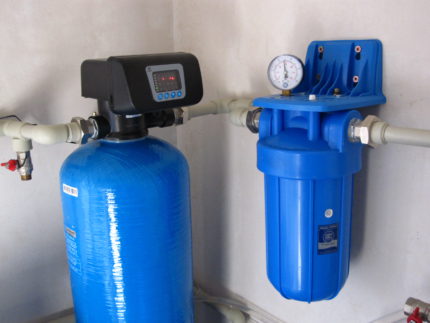
In non-reagent type devices with natural aeration, iron oxidation occurs in the storage tank. This process takes significantly longer than with artificial air saturation. There is no compressor here. After oxidation, the pump pumps the water directly to the iron remover.
Reagent type filters remove iron by catalytic method. The element is oxidized on the surface of granules of a special medium with filtering abilities, and the retention of the resulting compounds is in its thickness.
Such systems are highly efficient and compact.They are cheaper than non-reagent analogues, but require regular expenses for the purchase of reagents.
Method # 4 - complete disinfection of water
Disinfectants are usually used in the final stage of water treatment. The main objective of this equipment is the destruction of bacteria and other microorganisms. The most common are ultraviolet sterilizers.
The disinfecting effect is achieved through a series of photochemical reactions. UV filters do not require any complicated maintenance, they only need to be changed periodically.
It is important to note that the chemical composition of water in the process of "sterilization" does not change.
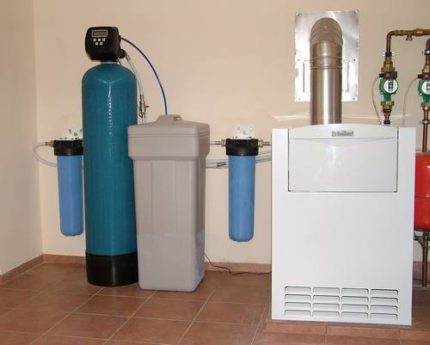
Method # 5 - reverse osmosis installations
The most effective method of obtaining water with drinking parameters is its purification by plants reverse osmosis. In this case, the liquid is passed through a special membrane that retains absolutely all foreign impurities. The water quality at the outlet of reverse osmosis systems is the highest possible, meeting the most stringent requirements.
The only flaw of reverse osmosis treatment is the absence of a mineral composition in the liquid. Special salt cartridges solve the problem. This equipment is quite compact, it fits quietly under the kitchen sink.
The site has a series of articles on reverse osmosis systems:
- Reverse osmosis: the harm and benefits of membrane purification of tap water
- How to choose a reverse osmosis filter: ranking of the best manufacturers and their products
- DIY reverse osmosis: step-by-step assembly and installation instructions
Useful Related Videos
Convincing arguments for the importance of conducting well water analysis:
An overview of the well water treatment system in the cottage:
The benefits of water treatment using reverse osmosis plants:
It is completely obvious that one should not neglect the periodic study of the chemical and microbiological composition of water. Contaminated fluid poses a very real threat to health, and it’s very naive to believe that it is from your well that Borjomi flows.
The vast majority of sources require water treatment to one degree or another. Properly selected filters will help to cope with any pollution and make the water truly clean and healthy.
Have experience cleaning water from a well? Please share information with our readers, tell us which filters and water treatment products you use. You can leave comments in the form below.

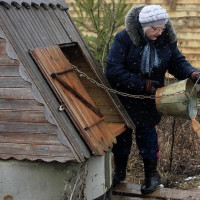 Why is muddy or yellow water in the well: causes of pollution and methods for their elimination
Why is muddy or yellow water in the well: causes of pollution and methods for their elimination 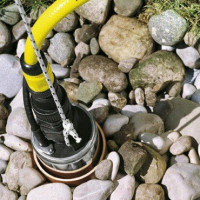 How to get a pump out of a well if it is stuck: first aid from professionals
How to get a pump out of a well if it is stuck: first aid from professionals 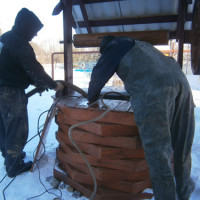 Water purification from a well: an overview of the best and most effective ways
Water purification from a well: an overview of the best and most effective ways  Maintenance of a well for water: rules for the competent operation of a mine
Maintenance of a well for water: rules for the competent operation of a mine 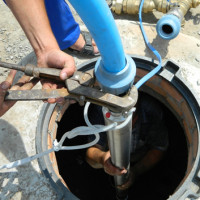 Do-it-yourself water well setup: how to properly equip a water source
Do-it-yourself water well setup: how to properly equip a water source  How much does it cost to connect gas to a private house: the price of organizing gas supply
How much does it cost to connect gas to a private house: the price of organizing gas supply  The best washing machines with dryer: model rating and customer tips
The best washing machines with dryer: model rating and customer tips  What is the color temperature of light and the nuances of choosing the temperature of the lamps to suit your needs
What is the color temperature of light and the nuances of choosing the temperature of the lamps to suit your needs  Replacement of a geyser in an apartment: replacement paperwork + basic norms and requirements
Replacement of a geyser in an apartment: replacement paperwork + basic norms and requirements
I use water from my own well myself. Of course, I heard that the water in it can be polluted under the influence of many reasons. I plan to soon conduct an analysis - you never know what microorganisms settled in it. If necessary, of course, I will take cleaning measures, since I don’t really want to drink contaminated water ...
Most recently, I completed drilling a well and equipping it. And now I’m putting a standard water purification system. I did not bother with various analyzes of water from the well, but I immediately think I will put the system in, and there it will already be visible.Later, I think I will improve and modernize this system, since water is very important, and I’m sure it’s not necessary to save on it.
Well, organics in well water is not the most important thing. In principle, I am interested in two questions - why put a bunch of filters if osmosis with a salt cartridge can handle everything? Filters also need to be cleaned as be. And another question is what can be found at a depth of 108 meter bore ... I think about heavy metals, but the question is, what parameters to transfer water to then?
Hello, Elena. Your answer already partially contains the answer to the question. When water is supplied from the well to the internal water supply, different filters are mounted that are responsible for a different degree of purification, plus they eliminate various impurities.
For example, coarse filters will carry out the initial cleaning of mineral particles ranging in size from 1000 microns to 2-3 mm, depending on the size of the mesh cell. They will delay organic pollution if the wellhead is not protected by a head.
But reverse osmosis at the molecular level will eliminate all kinds of tiny impurities. But it is very desirable that it contains a mineralizer, otherwise the water after such a cleaning turns out to be practically useless - devoid of the mineral content necessary for the body.
By and large, water must be checked for all indicators, from bacteriological to chemical. The cost of analysis for all the main 50 indicators will cost about $ 80. But the laboratory will also give recommendations on cleaning methods and devices. As a result, you can save money by not buying unnecessary equipment.
We have ferruginous water from a well; this is a constant problem in the Amur region. So, after the rough filter (this is enough), the water is normal, and visually, and to taste, there are no questions. But after heating in the boiler, it changes color, a slight chemical smell appears and, as it were, slightly darkens. The water heater is constantly being cleaned. What kind of reaction can this be?
The reaction with the color change of water during heating, which you observe, is similar to an increased concentration of iron. I advise you to analyze the water for all organoleptic, chemical, biological indicators, it will cost about $ 25.
If you have water with a high iron content coming from the well, then you need to install a filter that performs fine cleaning. In principle, in any reverse osmosis installation this module is. The price of a good filter for cleaning water from iron is about $ 130. But for complete cleaning, it is better to purchase reverse osmosis.
Nothing is said that the water from the wells may be different. These are groundwater from shallow wells (village wells), which are often saturated with all kinds of rubbish, and artesian water from wells with a depth of 150-200 m, which is impeccably clean. It is probably easier to immediately spend money on deep drilling than to bother with filtering all your life.
The cost of deep drilling is quite high. It’s not a fact that there isn’t any “rubbish” there, as there were cases when sewer drains were launched into artesian wells. A well with a depth of more than 100 m was drilled directly under the house, while laying the foundation. My personal opinion is that the analysis of water quality for all the main indicators should be carried out both during trial drilling and after the installation of a well to select a filtration system. In the conditions of our country, such measures are simply necessary.